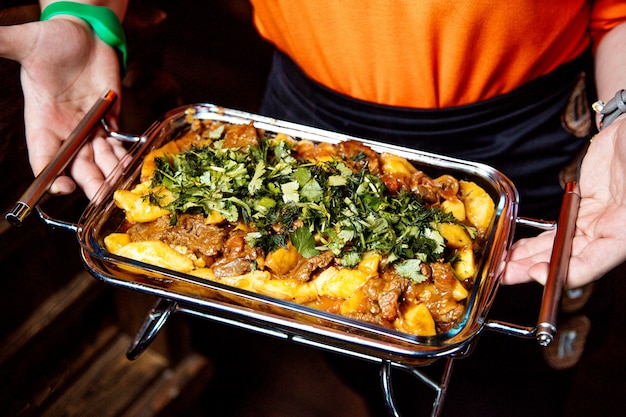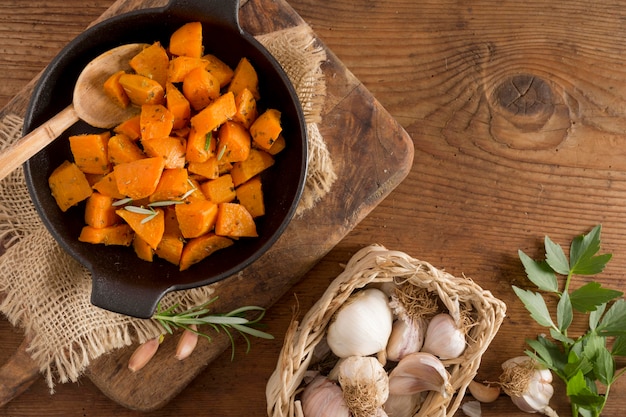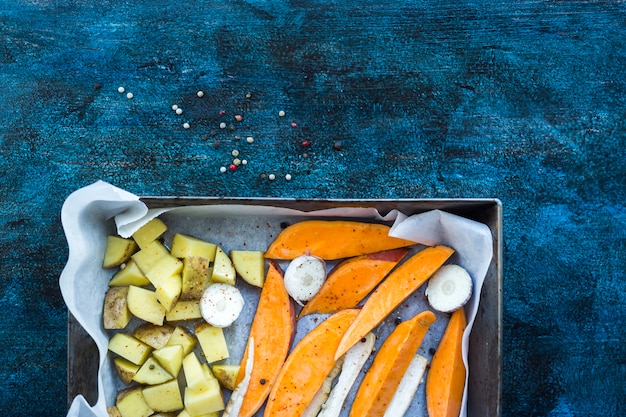Let's talk sweet potatoes, shall we? They're a real revelation, aren't they? Who knew this humble root vegetable could be so versatile? From sweet and fluffy mashed potatoes to crispy oven-baked fries, they're the chameleons of the culinary world. But for me, there's nothing quite like a perfectly baked sweet potato. It's simple, wholesome, and absolutely delicious.
But here's the thing: baking sweet potatoes can be a bit of a gamble. Sometimes you get that gorgeous golden-brown exterior and perfectly soft, sweet interior, and other times, you end up with a dry, tough mess. Trust me, I've been there, and it's not fun!
So, I'm going to share my hard-earned wisdom with you, my fellow baking enthusiasts. This guide is a bit like a cheat sheet for baking the most amazing sweet potatoes you've ever tasted. We'll cover everything from choosing the right sweet potato to the perfect baking time, with a few handy tips and tricks along the way. We'll even explore some delicious variations and side dishes.
Ready to embark on this sweet potato journey with me? Let's get baking!
(Part 1) Choosing the Right Sweet Potato

The first step to baking a perfect sweet potato is picking the right one. This might sound obvious, but trust me, it makes all the difference.
The Sweet Potato Test
Firstly, you want a sweet potato that's firm and smooth with no blemishes or soft spots. Give it a gentle squeeze – it should feel a bit springy, not mushy. Imagine squeezing a ripe avocado, that's the feeling you're looking for.
Next, check the colour. You're looking for a bright orange or deep red sweet potato. This usually means it's ripe and packed with flavour. Avoid any that are pale or have green patches – that's a sign they're past their best.
Types of Sweet Potatoes
There are different types of sweet potatoes out there, and each one has a unique flavour and texture. Here's a quick rundown:
Beauregard: This is my personal favourite, with its vibrant orange flesh and rich, sweet flavour. It's great for baking because it holds its shape well, perfect for those iconic mashed sweet potatoes.
Jewel: This variety has a beautiful purple skin and a creamy, sweet flesh. It's a bit more delicate than the Beauregard, but it still bakes beautifully.
Garnet: These sweet potatoes have a deep red flesh and a slightly nutty flavour. They're excellent for roasting, as they develop a lovely caramelized crust.
The Importance of Size
Now, let's talk about size. Remember, the bigger the sweet potato, the longer it will take to bake. For optimal results, I generally recommend using sweet potatoes that are about the size of a medium apple.
(Part 2) Preparing Your Sweet Potato

Right, now that you've got your perfect sweet potato, it's time to prep it for baking. This part is pretty straightforward, but there are a few things to keep in mind.
Wash and Dry
First things first, give your sweet potato a good scrub under cold running water. You want to remove any dirt or debris. Then, pat it dry with a clean kitchen towel.
Don't Peel (Unless You Really Want To)
Here's a bit of a controversial opinion: I'm a firm believer in leaving the skin on. It adds flavour, texture, and a bit of rustic charm to your baked sweet potato. Plus, you don't have to deal with peeling, which is a huge win in my book.
But if you're absolutely set on peeling, use a vegetable peeler to remove the skin. Just make sure to wash the sweet potato again after peeling.
Prick the Sweet Potato
This step is crucial! Pricking the sweet potato with a fork creates small vents that allow steam to escape during baking. This prevents the sweet potato from exploding in the oven – trust me, you don't want to see that!
You'll want to prick the sweet potato all over, making sure to get both sides. It's not rocket science, but it makes a world of difference. Think of it as creating little escape routes for all that delicious steam.
(Part 3) Baking Your Sweet Potato

Alright, now comes the fun part: baking! This is where you transform that humble sweet potato into a culinary masterpiece.
Preheat the Oven
Firstly, preheat your oven to 400°F (200°C). This is the ideal temperature for baking sweet potatoes, as it creates a nice even heat that cooks them thoroughly.
The Baking Time
The baking time will vary depending on the size of your sweet potato. Here's a general guideline:
Small Sweet Potato (about 6 inches long): 45 minutes to 1 hour
Medium Sweet Potato (about 8 inches long): 1 hour to 1 hour and 15 minutes
Large Sweet Potato (about 10 inches long): 1 hour and 15 minutes to 1 hour and 30 minutes
Wrap or Not to Wrap
This is a bit of a personal preference, but I like to wrap my sweet potatoes in foil before baking. It helps them to cook evenly and prevents the skin from drying out. Plus, it gives them a lovely, steamed texture.
If you choose to wrap your sweet potatoes, make sure to use heavy-duty foil and to seal the edges tightly. Think of it as giving your sweet potatoes a cozy little blanket.
The Baking Process
Once your oven is preheated, place your sweet potato(s) on a baking sheet lined with parchment paper. If you're wrapping them, place them directly on the baking sheet. If you're not, you might want to spread them out a bit so that they have some space to breathe.
Then, bake for the recommended time, depending on the size of your sweet potato. You can use a fork to test for doneness. If it goes in easily and comes out clean, then it's ready.
(Part 4) Recognizing a Perfectly Baked Sweet Potato
Okay, so your sweet potato has been in the oven for what seems like an eternity. How do you know when it's actually ready to be devoured?
The doneness test
Here's a simple way to check:
The Fork Test: Insert a fork into the widest part of the sweet potato. If it goes in easily and comes out clean, it's cooked through.
The Squeeze Test: Gently squeeze the sweet potato. It should feel soft and yielding, not hard and resistant.
The Colour Test: The skin should have turned a beautiful golden brown and may have even started to caramelize in spots. This is a sign of a perfectly baked sweet potato.
Troubleshooting
If your sweet potato is still hard after the recommended baking time, don't despair! You can simply bake it for a few more minutes, checking it every 5 minutes until it's cooked through.
Burnt Sweet Potatoes
On the flip side, if your sweet potato is looking a bit too brown and crispy, you might have overcooked it. Don't worry, it's still edible, just a bit more intensely flavoured. You can always scoop out the soft part and enjoy it.
(Part 5) Preparing Your Baked Sweet Potato for Eating
The anticipation is building, right? You've got your perfectly baked sweet potato, so now it's time to prepare it for eating.
Let it Cool
Take your baked sweet potato out of the oven and let it rest for a few minutes. This allows the heat to distribute evenly, making the flesh even softer and easier to work with.
Remove the Skin
If you left the skin on, it's now time to remove it. Simply cut a small slice off the top of the sweet potato and use a spoon to scoop out the flesh. The skin will easily peel off, revealing a beautiful, golden-brown interior.
Mashed or Whole
You've got two main options here:
Mashed: If you want a classic sweet potato side dish, you can mash the flesh with a fork or potato masher. Add a dollop of butter, a sprinkle of salt, and maybe some cinnamon for extra flavour.
Whole: If you prefer a more rustic approach, you can enjoy your baked sweet potato whole. Simply cut it in half lengthwise and eat it directly from the skin.
Topping Options
Now comes the fun part – toppings! The beauty of baked sweet potatoes is that they can be dressed up in countless ways. Here are a few of my favourites:
A drizzle of honey and a sprinkle of pecans
A dollop of yogurt and a sprinkle of granola
A scoop of vanilla ice cream and a sprinkle of cinnamon
A dollop of whipped cream and a sprinkle of chopped dates
(Part 6) Sweet Potato Side Dishes
Baked sweet potatoes can be the star of the show or the perfect sidekick to your main course. Here are a few ideas for incorporating them into your meals:
sweet potato mash
This is a classic for a reason! Simply mash the flesh of your baked sweet potato and add a dollop of butter, a sprinkle of salt, and maybe a bit of black pepper. You can also get creative with herbs like rosemary or thyme. For an extra touch, try adding a bit of maple syrup or honey for a touch of sweetness.
sweet potato fries
Cut your baked sweet potato into fries, toss them with a little olive oil, salt, and pepper, and bake them for another 10-15 minutes. You'll get crispy fries with a sweet and savory flavour. Try adding some paprika or cayenne pepper for a bit of heat.
sweet potato salad
Combine the flesh of your baked sweet potato with chopped pecans, cranberries, and a light vinaigrette. This makes a refreshing and healthy side dish. You can also add some crumbled goat cheese or feta for a tangy twist.
Sweet potato soup
roasted sweet potatoes are the perfect base for a creamy and comforting soup. Simply blend the flesh with vegetable broth, a little cream, and your favourite spices. Try adding some ginger, garlic, and cumin for a flavourful and warming soup.
(Part 7) Sweet Potato Baking Variations
The beauty of baked sweet potatoes is that they're incredibly versatile. Here are a few variations to try:
Spicy Sweet Potatoes
Add a kick to your baked sweet potatoes by sprinkling them with chili powder, paprika, or cayenne pepper before baking. For a really fiery experience, try a sprinkle of chipotle powder.
Sweet and Savory Sweet Potatoes
For a more complex flavour profile, try adding a touch of savory sweetness. Drizzle the sweet potatoes with a little maple syrup or agave nectar and sprinkle with a pinch of salt before baking. This adds a delightful contrast of flavours.
stuffed sweet potatoes
For a more substantial meal, try stuffing your baked sweet potatoes. Scoop out the flesh, mash it, and then mix it with your favourite ingredients like black beans, corn, or quinoa. You can also add chopped cilantro, salsa, or a sprinkle of cheese.
Sweet potato bread
Baked sweet potatoes can also be used to make delicious sweet potato bread. Simply mash the flesh and add it to your favourite bread recipe. You can find countless recipes online for sweet potato bread, from classic to more unique variations.
(Part 8) FAQs
What if my sweet potato is too hard to bake?
Don't worry! You can soften it up by soaking it in hot water for 30 minutes before baking. This will help to rehydrate the sweet potato and make it easier to bake.
How long can I store a baked sweet potato?
A baked sweet potato will last for about 3 days in the fridge, wrapped tightly in plastic wrap.
Can I bake sweet potatoes from frozen?
Yes, you can! But you will need to add a little extra time to the baking time. It might take 15-20 minutes longer than a fresh sweet potato.
Is there a way to make my baked sweet potato extra sweet?
You can drizzle your sweet potato with a little maple syrup, honey, or agave nectar before baking. This will add a touch of sweetness and create a lovely glaze.
Can I bake sweet potatoes in the microwave?
Yes, you can! It will cook much faster, but the texture won't be as good. It will be softer and more mushy. Microwave baking is great for a quick fix, but for the best texture and flavour, stick with the oven.
(Part 9) Final Thoughts
I hope this guide has given you all the tools and confidence you need to bake perfect sweet potatoes every time. Remember, it's all about choosing the right sweet potato, preparing it properly, and baking it to perfection.
So, go forth and bake, my friends! And let me know what you think in the comments below. I'm always eager to hear about your sweet potato baking adventures! You might just inspire my next baking masterpiece!
Everyone is watching

Corn on the Cob: The Ultimate Guide to Perfectly Cooked Ears
Healthy MealsAh, corn on the cob. Just the name evokes images of sunny days, barbecues, and that sweet, juicy flavour that ...

Perfect Pork Roast Oven Cooking Time: A Guide to Delicious Results
Healthy MealsThere's something truly satisfying about a perfectly roasted pork. The aroma alone is enough to make your mout...

Ham Cooking Time: How Long to Bake, Smoke, or Boil a Delicious Ham
Healthy MealsAh, ham. It's a classic, isn't it? A real crowd-pleaser, especially around holidays. And when done right, it'...

Scallops: The Ultimate Guide to Perfect Cooking
Healthy MealsAh, scallops. Those delicate, sweet, and utterly delicious morsels of the sea. They hold a special place in my...

Spaghetti Squash: The Ultimate Guide to Cooking and Serving
Healthy MealsRemember that time you saw spaghetti squash at the supermarket, looking all bumpy and strange, and thought, "W...
